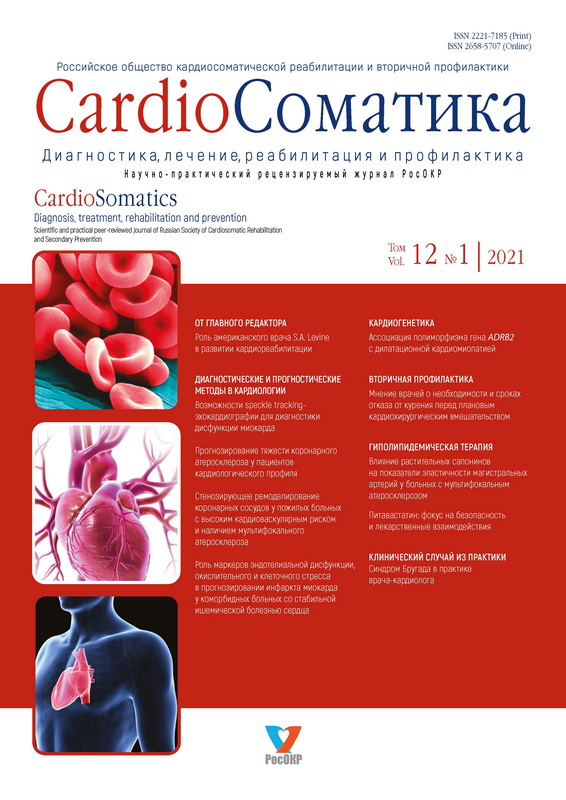Predicting the coronary atherosclerosis severity in cardiac patients
- Authors: Fedulaev Y.N.1, Makarova I.V.1, Pinchuk T.V.1, Arakelov S.E.2,3, Titova I.Y.4
-
Affiliations:
- Pirogov Russian National Research Medical University
- City Clinical Hospital № 13
- People’s Friendship University of Russia
- City Clinical hospital №13
- Issue: Vol 12, No 1 (2021)
- Pages: 11-14
- Section: Original study articles
- Submitted: 08.12.2020
- Published: 26.05.2021
- URL: https://cardiosomatics.ru/2221-7185/article/view/52818
- DOI: https://doi.org/10.26442/22217185.2021.1.200766
- ID: 52818
Cite item
Full Text
Abstract
Background. Coronary atherosclerosis is an ongoing pathological process, varying from asymptomatic forms to angina pectoris, myocardial infarction and even sudden cardiac death. Early identification of persons with an increased risk of the severe atherosclerosis will promote adequate diagnostic and therapeutic measures to prevent cardiovascular complications.
Aim. To make a prognostic model determining the probability of a severe coronary atherosclerosis in cardiac patients.
Material and methods. The actual study included 116 patients of cardiology departments with various degree of coronary atherosclerosis measured by coronary angiography: group I ≥70% coronary stenosis (≥50% in case of left main coronary artery), group II – those with less severe atherosclerotic process. All patients underwent electrocardiography (ECG) at rest and Holter monitoring. Pathological Q-waves, qualitative and quantitative characteristics of ventricular extrasystoles as well as QRS-fragmentation were assessed in all cases. In individuals having sinus rhythm, heart rate turbulence (HRT), T-wave alternans and QT, QTc dispersion on maximum and minimum heart rate were additionally calculated.
Results. The prognostic model included the following ECG-markers: HRT, pathological Q-waves, QTc dispersion on maximum heart rate and QRS-fragmentation in lateral leads (I, AVL, V6). All parameters have demonstrated a direct relationship with the likelihood of severe coronary atherosclerosis. The current model took into account 71% of the factors influencing significant atherosclerosis, AUC=0.94±0.04, the sensitivity and the specificity were 90.0 and 94.4% respectively.
Conclusion. A comprehensive assessment of the ECG data helps to identify the group with an increased risk of severe coronary atherosclerosis among cardiac patients.
Full Text
About the authors
Yuri N. Fedulaev
Pirogov Russian National Research Medical University
Email: kuwert@yandex.ru
ORCID iD: 0000-0003-4040-2971
SPIN-code: 2764-7250
D. Sci. (Med.), Prof., Head of the Department of Faculty Therapy
Russian Federation, 117997, Moscow, Ostrovitianov Street, 1Irina V. Makarova
Pirogov Russian National Research Medical University
Author for correspondence.
Email: irina-makarova93@mail.ru
ORCID iD: 0000-0001-5127-1300
SPIN-code: 3525-1775
ResearcherId: ABE-1969-2020
assistant of the Department of Faculty Therapy
Russian Federation, 117997, Moscow, Ostrovitianov Street, 1Tatiana V. Pinchuk
Pirogov Russian National Research Medical University
Email: doktor2000@inbox.ru
ORCID iD: 0000-0002-7877-4407
SPIN-code: 1940-2017
Cand. Sci. (Med.), Department of Faculty Therapy
Russian Federation, 117997, Moscow, Ostrovitianov Street, 1Sergey E. Arakelov
City Clinical Hospital № 13; People’s Friendship University of Russia
Email: kuwert@yandex.ru
ORCID iD: 0000-0003-3911-8543
D. Sci. (Med.), chief physician of city clinical hospital 13, head of the Department of Family Medicine with a course of palliative care at the RUDN University
Russian Federation, 115280, Moscow, Velozavodskaya Street, 1/1; MoscowIrina Y. Titova
City Clinical hospital №13
Email: kuwert@yandex.ru
ORCID iD: 0000-0001-7056-0634
Deputy Chief of City Clinical Hospital №13
Russian Federation, 115280, Moscow, Velozavodskaya Street, 1/1References
- Parsons C, Agasthi P, Mookadam F, Arsanjani R. Reversal of coronary atherosclerosis: Role of life style and medical management. Trends Cardiovasc Med 2018; 28 (8): 524–31.
- Boudoulas KD, Triposciadis F, Geleris P, Boudoulas H. Coronary Atherosclerosis: Pathophysiologic Basis for Diagnosis and Management. Prog Cardiovasc Dis 2016; 58 (6): 676–92.
- Knuuti J, Wijns W, Achenbach S, et al. 2019 ESC guidelines for the diagnosis and management of chronic coronary syndromes. Eur Heart J 2020; 3 (41): 407–77.
- Gutterman DD. Silent myocardial ischemia. Circ J 2009; 73 (5): 785–97.
- Das MK, Saha C, El Masry H, et al. Fragmented QRS on a 12-lead ECG: A predictor of mortality and cardiac events in patients with coronary artery disease. Heart Rhythm 2007; 4: 1385–92.
- Das MK, Suradi H, Maskoun W, et al. Fragmented wide QRS on a 12-lead ECG: a sign of myocardial scar and poor prognosis. Circ Arrhythm Electrophysiol 2008; 1 (4): 258–68.
- Bauer A, Malik M, Schmidt G, et al. Heart rate turbulence: standards of measurement, physiological interpretation, and clinical use: International Society for Holter and Noninvasive Electrophysiology Consensus. J Am Coll Cardiol 2008; 52 (17): 1353–65.
- Hostetler B, Xue J, Young B, et al. Detect short run of TWA event with time-domain algorithm. Comput Cardiol 2005; 32: 483–6.
- Mowatt G, Cook JA, Hillis GS, et al. 64-Slice computed tomography angiography in the diagnosis and assessment of coronary artery disease: systematic review and meta-analysis. Heart 2008; 94 (11): 1386–93.
- Prati F. Utilizzo appropriato dell’angiografia coronarica con tomografia computerizzata nella cardiopatia ischemica: indicazioni e limiti [Coronary computed tomography angiography in coronary heart disease: clinical applications and limitations]. G Ital Cardiol (Rome) 2019; 20 (7): 409–16.
- Веселовская Н.Г., Чумакова Г.А., Шенкова Н.Н., и др. Модель прогнозирования риска коронарного атеросклероза у пациентов с висцеральным ожирением. Рос. кардиол. журн. 2015; 4 (120): 49–54 [Veselovskaia NG, Chumakova GA, Shenkova NN, et al. Model' prognozirovaniia riska koronarnogo ateroskleroza u patsientov s vistseral'nym ozhireniem. Ros. kardiol. zhurn. 2015; 4 (120): 49–54 (in Russian)].
- Котельникова Е.В., Гриднев В.И., Довгалевский П.Я., Беспятов А.Б. Прогнозирование коронарного атеросклероза для выбора тактики ведения больных ишемической болезнью сердца в амбулаторной практике. Кардиология. 2004; 44 (3): 15–9 [Kotel'nikova EV, Gridnev VI, Dovgalevskii PIa, Bespiatov AB. Prognozirovanie koronarnogo ateroskleroza dlia vybora taktiki vedeniia bol'nykh ishemicheskoi bolezn'iu serdtsa v ambulatornoi praktike. Kardiologiia. 2004; 44 (3): 15–9 (in Russian)].
- Шарафеев А.З., Зыятдинов К.Ш., Акберов Р.Ф. Возможности ультразвукового ангиосканирования в раннем выявлении коронарного атеросклероза. Казан. мед. журн. 2011; 92 (4): 525–9 [Sharafeev AZ, Zyiatdinov KSh, Akberov RF. Vozmozhnosti ul'trazvukovogo angioskanirovaniia v rannem vyiavlenii koronarnogo ateroskleroza. Kazan. med. zhurn. 2011; 92 (4): 525–9 (in Russian)].
Supplementary files









